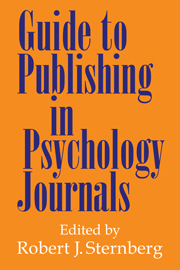Book contents
- Frontmatter
- Contents
- Preface
- PART ONE INTRODUCTION
- PART TWO PARTS OF AN ARTICLE
- 3 Titles and Abstracts: They Only Sound Unimportant
- 4 Introducing Your Research Report: Writing the Introduction
- 5 Theories and Hypotheses
- 6 Writing Effectively about Design
- 7 Doing Data Analyses and Writing Up Their Results: Selected Tricks and Artifices
- 8 Results That Get Results: Telling a Good Story
- 9 What Does It All Mean? The Discussion
- 10 Documenting Your Scholarship: Citations and References
- PART THREE DEALING WITH REFEREES
- PART FOUR CONCLUSION
- Index
4 - Introducing Your Research Report: Writing the Introduction
Published online by Cambridge University Press: 05 February 2012
- Frontmatter
- Contents
- Preface
- PART ONE INTRODUCTION
- PART TWO PARTS OF AN ARTICLE
- 3 Titles and Abstracts: They Only Sound Unimportant
- 4 Introducing Your Research Report: Writing the Introduction
- 5 Theories and Hypotheses
- 6 Writing Effectively about Design
- 7 Doing Data Analyses and Writing Up Their Results: Selected Tricks and Artifices
- 8 Results That Get Results: Telling a Good Story
- 9 What Does It All Mean? The Discussion
- 10 Documenting Your Scholarship: Citations and References
- PART THREE DEALING WITH REFEREES
- PART FOUR CONCLUSION
- Index
Summary
Drafting an introduction may feel like a daunting task. The writer must engage the audience in his or her research, provide the necessary background information about the topic, and set the stage for the study itself. How is this accomplished? First and foremost, there is no one formula. Consider the following. As undergraduates prepare to apply to graduate school they often ask faculty, “What makes a successful application?” The applicants invariably think in a formulaic fashion, believing that a secret formula exists - something akin to four parts research, two parts practical experience, GREs over a cutoff score, and an undergraduate GPA of at least 3.5. They believe that adherence to the recipe will fashion the ideal candidate. Sorry, there is no rigid formula. In fact, whereas the ingredients of the formula are indeed important to the evaluation process, different schools look differently at the varying credentials.
Likewise, journal editors and readers alike expect the introduction section of an article to contain certain features, but again there is no formula. The components of the introduction fit within a general framework that allows the researcher to describe the study and to provide a rationale for its implementation. The framework of the introduction consists of three segments – unequal in length but each essential in conveying the background and purpose of the study. The first segment, often the opening paragraph, sets the broad stage for the research and draws the reader's interest.
- Type
- Chapter
- Information
- Guide to Publishing in Psychology Journals , pp. 41 - 57Publisher: Cambridge University PressPrint publication year: 2000
- 6
- Cited by

